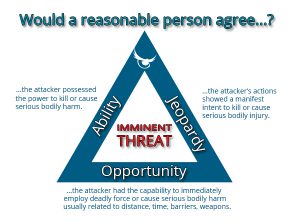I’ve historically been a supporter of law enforcement. (I confess to having made jokes about donuts, etc., but in fairness, I also make preacher jokes.) Among other things, I’ve always been taught that police officers have great courage and have the discipline to show great restraint, even under very tense situations. I’ve watched shows that portray officers going through a staged environment where cardboard cut-outs spring up. I’ve watched as they fire shots into the mocked-up thug pointing a gun, while NOT firing at the cardboard paper boy. Honesty, I’ve always thought that I could never do that! Those that can get my admiration.

In light of recent circumstances, however, I questioned what was considered proper for police officers to use deadly force. I had my own beliefs but I wanted to have that belief either confirmed or denied. Doing a little research, I found this diagram to explain when officers use deadly force:

Another person sent me a copy of text directly from an officer’s manual. It is is worth reading::
“Deadly force is force that is intended to or likely to cause death. Whenever safety permits, police officers should identify themselves and state their intent to shoot prior to using a firearm. Officers are to discharge their weapons to stop an assailant from completing a potentially deadly act as described. Officers should shoot to stop the threat and to minimize danger to innocent bystanders.
An officer may use deadly force:
- As a last resort in defense of oneself, when there is reasonable cause to believe that the officer is in imminent danger of death or great bodily harm.
- As a last resort in defense of another person, whom the officer has reasonable cause to believe is being unlawfully attacked and is in imminent danger of death or great bodily harm.
- As a last resort to prevent escape of a suspect where the officer has probable cause to believe that the person to be arrested has used deadly force in the commission of a felony and the officer reasonably believes there is no other way to make the arrest or retain the custody of the person once arrested, or the person to be arrested can reasonably be thought to be intent on endangering human life or upon inflicting serious bodily harm. In any event, the officer should not use deadly force unless he/she believes it is necessary and then only as a last resort.”
That diagram and that excerpt from an officer’s manual go right along with what I’ve always believed. Lethal action hinges on terms like, “last resort,” and, “imminent danger of death or great bodily harm.” I repeat that I’ve always had great admiration and respect for officers for having the courage, restraint, and discipline to follow these principles. I know it wouldn’t be easy. I don’t believe I would have the nerve, so kudos to those men and women in uniform who do.
Now, I want to illustrate the principle as I understand it: If I’m standing five feet in front of an officer, with my back turned to the officer, with a gun in my hand pointed at the ground, the officer is supposed to show courage, discipline, and restraint and not shoot me. (While I have a weapon, since I am facing away and pointing at the ground I am not showing intent nor am I able to shoot anyone from that position.) If I then begin the raise the weapon and suddenly spin to face the officer, that IS creating imminent danger and the officer would be justified, as a last resort, to shoot me.
Now, in the wake of the, “officer-involved shooting,” of suspect, Jacob Blake, a video has circulated showing the suspect ignoring instructions from police officers and trying to get away from them. As he tries to access a vehicle, an officer pulls on his shirt from behind and fires seven shots into his back. Jacob Blake survived (probably paralyzed but he lived) but I think there is widespread agreement that seven shots meets the definition of deadly force (“likely to cause death”). There may be a lot of factors and variables that we don’t know and that is why we await the final report from the investigation.
Meanwhile, however, without having the final report and without knowing of additional details, I’m repeatedly reading, from multiple sources, that hypothetically, since the suspect had a record and was non-compliant, and since the officer didn’t know why the suspect was trying to access the vehicle, the officer was fully justified to use deadly force.
I’m sorry to say that this hypothetical stance concerns me. When analyzed, it is but a lightly-cloaked version of, “shoot first and ask questions later.” It reveals a standard very different from, “last resort,” and, “imminent danger of death or great bodily harm.”
Again, restating the disclaimer that the final post-investigation report is not available yet, hypothetically, I would rather believe that this kind of shooting is an anomaly; that it represents a failure to adhere to established principles. I would rather believe that it is not standard operating procedure for our police officers to shoot a person in the back because MAYBE the situation was going to escalate. I would rather believe that the vast, vast majority of our police officers are still exhibiting the courage, restraint, and discipline to reserve deadly force as a, “last resort” when under “threat of imminent danger of death or great bodily harm.”
I say Kudos to all the men and women in law enforcement who live up to that high ideal. Those officers have my support. To those who can’t (or won’t) live up to that high ideal, sorry, but law enforcement is not for them.
